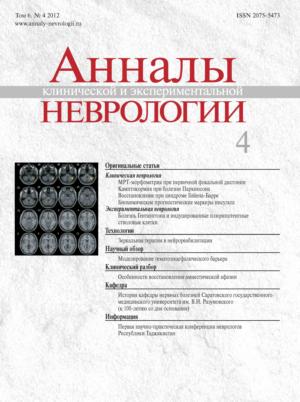Синдром Гийена–Барре: особенности восстановления демиелинизирующих и аксональных форм
- Авторы: Гришина Д.А.1, Супонева Н.А.1, Пирадов М.А.1
-
Учреждения:
- ФГБНУ «Научный центр неврологии»
- Выпуск: Том 6, № 4 (2012)
- Страницы: 18-25
- Раздел: Оригинальные статьи
- Дата подачи: 02.02.2017
- Дата публикации: 10.02.2017
- URL: https://annaly-nevrologii.com/journal/pathID/article/view/257
- DOI: https://doi.org/10.17816/psaic257
- ID: 257
Цитировать
Полный текст
Аннотация
Проведено обследование 74 пациентов, перенесших синдром Гийена-Барре (СГБ) с выраженным нарушением двигательных функций от 3 месяцев до 36 лет назад. Средний срок наблюдения составил 2,3 года. Острую воспалительную демиелинизирующую полиневропатию (ОВДП) перенесли 58 чел., остальные 16 пациентов – аксональные формы СГБ. Установлено, что в структуре остаточного неврологического дефицита у больных с ОВДП на всех этапах восстановительного (катамнез <1 года) и отдаленного (>1 года) периодов преобладают чувствительные нарушения и болевой синдром. Подавляющее большинство больных с ОВДП (90%) начинают ходить с поддержкой спустя месяц от начала заболевания, в единичных случаях (3%) – через полгода. При аксональных формах пациенты встают на ноги лишь спустя 6 месяцев (88%) и позднее (12% пациентов – до 12 месяцев). Через год от начала заболевания все пациенты с ОВДП ходят самостоятельно и большинство приступает к прежней работе. В эти же сроки каждый третий больной с аксональной формой ограничен в самообслуживании. Таким образом, подтверждено суждение о СГБ как о заболевании с благоприятным прогнозом: даже в тяжелых случаях у подавляющего числа пациентов к полугоду отмечается восстановление ходьбы вне зависимости от аксональной или демиелинизирующей формы заболевания. Аксональные формы отличаются от ОВДП более медленным темпом восстановления и большей степенью выраженности остаточных явлений, что снижает показатели качества жизни больных.
Ключевые слова
Об авторах
Дарья Александровна Гришина
ФГБНУ «Научный центр неврологии»
Автор, ответственный за переписку.
Email: Grishina82@gmail.com
Россия, Москва
Наталья Александровна Супонева
ФГБНУ «Научный центр неврологии»
Email: Grishina82@gmail.com
ORCID iD: 0000-0003-3956-6362
член-корреспондент РАН, профессор РАН, д.м.н., г.н.с. отд. нейрореабилитации и физиотерапии
Россия, 125367, Москва, Волоколамское шоссе, д. 80Михаил Александрович Пирадов
ФГБНУ «Научный центр неврологии»
Email: Grishina82@gmail.com
ORCID iD: 0000-0002-6338-0392
академик РАН, профессор, д.м.н., директор
Россия, 125367, Москва, Волоколамское шоссе, д. 80Список литературы
- Баженов С.А. Качество жизни населения: теория и практика. М.: ЭКОС, 2002.
- Гехт Б.М., Никитин С.С. Механизмы компенсаторной реиннервации при повреждении аксона периферических нервов. Журн. неврол. и психиатрии им. С.С. Корсакова 1986; 2: 294–300.
- Гехт Б.М., Касаткина Л.Ф., Самойлов М.И., Санадзе А.Г. Электромиография в диагностике нервно-мышечных заболеваний. Таганрог: ТРТУ, 1997.
- Пирадов М.А. Синдром Гийена-Барре. М.: Интермедика, 2003.
- Пирадов М.А., Супонева Н.А. Синдром Гийена-Барре: современная диагностика и тактика лечения. В сб.: Труды Нац. кон- гресса «Неотложные состояния в неврологии» (под ред. З.А. Суслиной, М.А. Пирадова). М., 2009: 190–196.
- Пирадов М.А., Супонева Н.А. Синдром Гийена-Барре: современное состояние проблемы. В сб.: I Нац. конф. с межд. участием «Нейроинфекции». М., 2007: 99–102.
- Пирадов М.А., Супонева Н.А. Синдром Гийена-Барре: диагностика и лечение. Руководство для врачей. М: Медпресс, 2011.
- Супонева Н.А., Никитин С.С., Пирадов М.А. Воспалительные полиневропатии: проблемная ситуация в России. Современные наукоемкие технологии 2010; 2: 114–115.
- Супонева Н.А., Пирадов М.А., Никитин С.С., Павлов Э.В. Анализ причин острого вялого тетрапареза на примере москов- ской популяции. В сб.: Труды Нац. конгресса «Неотложные состояния в неврологии» (под ред. З.А. Суслиной, М.А. Пирадова). М., 2009: 345.
- Супонева Н.А. Лечение тяжелых полиневропатий. В сб.: Труды II Нац. конгресса «Неотложные состояния в неврологии» (под ред. З.А. Суслиной, М.А. Пирадова). М., 2011: 86–91.
- Bernsen R.A., Jager A.E., Schmitz P.I. et al. Long-term sensory deficit after Guillain-Barré syndrome. Neurology 2001; 248: 483–486.
- Bernsen R.A., Jager A.E., Meché F.G. et al. How Guillain-Barre patients experience their functioning after 1 year. Acta Neurol. Scand. 2005; 112: 51–56.
- Bernsen R.A., Jacobs H.M., Jager A.E. Residual health status after Guillain-Barre syndrome. J. Neurol. Neurosurg. Psychiatry 1997; 62: 637–640.
- Bersano A., Carpo M., Allaria S. et al. Long term disability and social status change after Guillain-Barré syndrome. Neurology 2006; 253: 214–218.
- Chio A., Cocito D., Leone M. et al. Guillain-Barre syndrome: a prospective, population-based incidence and outcome survey. Neurology 2003; 60: 1146–1150.
- Dorrnonville de la Cour C., Jakobsen J. Residual neuropathy in londterm population-based follow-up of Guillain-Barre syndrome. Neurology 2005; 64: 246–253.
- Forsberg A., Press R., Einarsson U. et al. Disability and health-related quality of life in Guillain-Barré syndrome during the first two years after onset: a prospective study. Clin. Rehabil. 2005; 19: 900–909.
- Hadden R.D., Cornblath D.R., Hughes R.A. et al. Electrophysiological classification of Guillain-Barre syndrome: clinical association and outcome. Ann. Neurol. 1998; 44: 780–788.
- Hadden R.D. Preceding infection, immune factors and outcome in Guillain-Barre syndrome. Neurology 2001, 56: 758–765.
- Hiraga A., Mori M., Ogawara K. et al. Recovery patterns and long term prognosis for axonal Guillain-Barre syndrome. J. Neurol. Neurosurg. Psychiatry 2005; 76: 719–722.
- Ho T.W., Li C.Y., Cornblath D.R. et al. Patterns of recovery in the Guillain-Barre syndrome. Neurology 1997; 48: 695–700.
- Hughes R.A., Hadden R.D., Rees J.H., Swan A.V. The prognosis and main prognostic indicators of Guillain-Barré syndrome. A multicentre prospective study of 297 patients. The Italian Guillain-Barre Study Group. Brain 1996; 119: 2053–2061.
- Jager A.E., Minderhoud J.M. Residual signs in severe Guillain-Barré syndrome: analysis of 57 patients. Neurol. Sci. 1991; 104: 151–156.
- Koeppen S., Kraywinkel K., Wessendorf T.E. et al. Long-term outcome of Guillain-Barré syndrome. Neurocrit. Care 2006; 5: 235–242.
- Koningsveld R., Steyerberg E.W., Hughes R.A. et al. A clinical prognostic scoring system for Guillain-Barre syndrome. Lancet Neurol. 2007; 6: 589–594.
- Tamura N., Kuwabara S., Misawa S. Time course of axonal regeneration in acute motor axonal neuropathy. Muscle Nerve 2007; 35: 793–795
Дополнительные файлы









